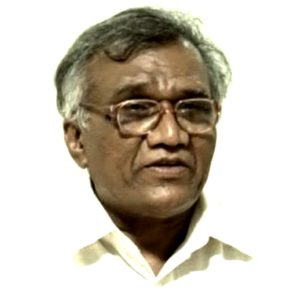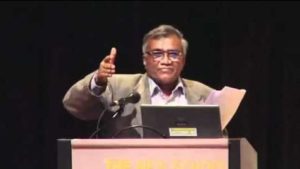 Gopal Guru pioneered new dimensions in the re-thinking of Dalit discourse with the introduction of critical theory in understanding questions of constructions and fallout of Dalit identity in India. Central to his work is to testify to the normative set up of the Indian public sphere in order to understand its patterns of inclusivity and exclusivity towards the members of society. His work brings ethics back into theorizing and philosophizing Dalit discourses which, for decades, were lost in the debates of representational politics. His writings can be broadly located in theorizing on the moral categories of self-respect, recognition, dignity, shame, humiliation and asserting a non-instrumentalist view of rationality in explaining matters of social justice.
Gopal Guru pioneered new dimensions in the re-thinking of Dalit discourse with the introduction of critical theory in understanding questions of constructions and fallout of Dalit identity in India. Central to his work is to testify to the normative set up of the Indian public sphere in order to understand its patterns of inclusivity and exclusivity towards the members of society. His work brings ethics back into theorizing and philosophizing Dalit discourses which, for decades, were lost in the debates of representational politics. His writings can be broadly located in theorizing on the moral categories of self-respect, recognition, dignity, shame, humiliation and asserting a non-instrumentalist view of rationality in explaining matters of social justice.
The Dalit pursuit of modernity in his works is based on the language of rights for fostering equality in interpersonal relations among communities. The foundation of these rights is built upon the Kantian notion of self respect and the Hegelian understanding of recognition. Thus it resists the ethics of postmodernism and neo-liberalism described in terms of benevolence and charity. Hence, for Gopal Guru, the new language of rights among Dalits ‘grew out of rejection of the language of obligation that entailed negative rights’ (Guru 2000: 123).
To a large extent, Guru located structures of oppression like caste, Brahmanism and patriarchy as the epitome of a Hobbesian ‘survival of fittest’ politics which neatly fits with the pragmatic, calculative and self-preservatory individual of the neoliberal order. Like the Hobbesian self seeks its cultivation and preservation through the Leviathan or in a Nietzschean sense through the Ubermensch, brahminhood for Guru seeks to secure itself through sanskritization (Guru 2009: 51). Such a pragmatic self of brahminhood stands antithetical to lower castes’ struggle in achieving the principle of ‘one person one value’. This is related to the Aristotelian spirit of connecting the private and public which is ‘bound by the totality of moral qualities of the good man’ (Guru 2009: 56).
Gopal Guru builds upon the claims of critical theorist Pierre Bourdieu’s ‘cultural capital’ to show the exclusionary nature of social sciences in India. Bourdieu’s analysis of French academia in terms of inspection of grades among the students shows a clear and visible relationship between hierarchy of epithets and hierarchy of social origin. Similarly in India, according to Guru ‘the strict observance of a language code, protocols, body language and ground rules effectively converts seminar halls into a hostile structure that very often inflict humiliation on the Dalits who then feel nervous or intimidated to enter such structures’ (Guru 2002: 5006). He understands that the public sphere of Indian academia in the social sciences ‘represents a pernicious divide between theoretical Brahmins and empirical shudras’ (Guru 2002: 5003). It is precisely this lack of ‘transformation of public sphere’ which is the primary factor for Guru that reinstates the crisis among the Dalits. Hence, instead of pursuing theory, they focus on non-conceptual, empirical, and private domains, especially poetry and autobiographical narratives. They utilize their experiences and depict them through similes, which in many ways sensitizes and generates sympathy in the public domain. But Guru does not agree with such prepositions as it lacks the dialectical power of the transformation of ideas which involves the argumentation process (as this process is based on objectivity and justificatory principles). This is the reason why for Guru ‘poetry helps Dalits in making a connection through metaphors but not through concepts’ and therefore poetry, for him, lacks the conceptual power ‘to universalize the particular and particularize the universal’ (Guru 2002: 5007). Dalits’ pursuit of theory signal a quest for reclaiming rationality and re-routing their ontology via epistemology, which becomes a gesture towards a Kantian liberal self who is an ‘end in themselves’ instead of a passive museumized amusing empirical object.
 While analyzing Ambedkar’s conversion to Buddhism, Guru criticized the spiritualized and Hinduized interpretation of right wing parties and Buddhist organizations like Trailokya Bauddha Mahasangha Sahayaka Gana (TBMSG) in Maharashtra, which distorted the vision of emancipation in Ambedkar’s Buddhism. ‘If one looks at Ambedkar’s ideology of Buddhism and his idea of conversion, one finds that he created a counter ideology in the form of neo-Buddhism thereby rejecting not only old Buddhism but also offered a dialectical undermining of Hinduism at the ideological level’ (Guru 1991: 339-341). Thus, Guru understands Ambedkar’s conversion to Buddhism in terms of a long term emancipatory politics for Dalits where the Gita as a text of obedience for Hindus will be counter cultured by Buddha and his Dhamma of Dalits (Guru ‘Appropriating Ambedkar’ 1991: 1697-1699).
While analyzing Ambedkar’s conversion to Buddhism, Guru criticized the spiritualized and Hinduized interpretation of right wing parties and Buddhist organizations like Trailokya Bauddha Mahasangha Sahayaka Gana (TBMSG) in Maharashtra, which distorted the vision of emancipation in Ambedkar’s Buddhism. ‘If one looks at Ambedkar’s ideology of Buddhism and his idea of conversion, one finds that he created a counter ideology in the form of neo-Buddhism thereby rejecting not only old Buddhism but also offered a dialectical undermining of Hinduism at the ideological level’ (Guru 1991: 339-341). Thus, Guru understands Ambedkar’s conversion to Buddhism in terms of a long term emancipatory politics for Dalits where the Gita as a text of obedience for Hindus will be counter cultured by Buddha and his Dhamma of Dalits (Guru ‘Appropriating Ambedkar’ 1991: 1697-1699).
The objectivity in Guru’s thought is well reflected in his arguments on the moment of ‘atrophy in dalit politics’. He argues against the discursive turn which is witnessed by the category Dalit and is now opened up for those who self-proclaimed themselves as ‘Dalit messiah’ and deploying the category for their personal gains. Thus Guru argued that ‘Dalit politics today has become rudderless and lost its real purpose in a hail of claims and counter-claims that are launched at it from both within and outside the Dalit platform’ (Guru 2005 : 5). Guru’s concerns in ‘atrophy in Dalit politics’ snatches away the embedded universalism in the Dalit category and leaves it open to be exploited by the relativist, pragmatic anti-foundationalist thought processes.
In the context of the Durban Conference (World Conference against Racism) 2001, Guru does not agree with equating casteism with racism because of the neglect of the ‘victims point of view’ on the issue. Such an indifference towards the victims’ point of view is evident in the mainstream media studio rooms of the country, where the visual media has projected Dalits in the form of a “caricature” which is not an authentic portrayal. Similarly in the print media, the subject was largely restricted to the English dailies, which are ‘sociologically blind towards the horizontal level of the vernacular public’ (Guru 2004: 244-245). Perhaps, for Guru, what was missing from the debate on caste and race in the Durban Conference is the notion of “self-reflectivity”. Thus the debate did not capture the bureaucratic-non-cognitive rationality played out by the state, which Guru identifies with the ‘ways in which global capital decides the agenda of the state’ (Guru ‘Guru, “What It Means To be an Indian Dalit’, 2009: 179).
Essential Readings
Guru, Gopal 1991. ‘Appropriating Ambedkar‘, Economic and Political Weekly, Vol. 26, No.27/28: 1697-1699.
Guru, Gopal 2004. “How Egalitarian are the Social Sciences in India?” Economic & Political Weekly, vol.37, No.5 (2002): 5003-09.
Guru, Gopal 2005. “Understanding the Category Dalit” in, Gopal Guru (eds.) Atrophy in Dalit Politics, Vikas Adhyayan Kendra, Mumbai.
Guru, Gopal (ed) 2009. Humiliation: Claims and Context, Oxford University Press, New Delhi.
Guru, Gopal & Sunder Sarukkai 2017. The Cracked Mirror, Oxford University Press, New Delhi.
Further Readings
Guru, Gopal 1991. “Hinduisation of Ambedkar in Maharashtra“, Economic and Political Weekly, Vol.26, No.7: 339-341.
Guru, Gopal 2000. “Dalits in Pursuit of Modernity”, in Romila Thapar (eds.) India: Another Millennium? Viking and Penguin Books, New Delhi.
Guru, Gopal 2001. “The language of Dalit-Bahujan Political Discourse”, in Ghanshyam Shah (eds.) Dalit Identity and Politics: Cultural Subordination and the Dalit Challenge, Vo/.2, Sage Publication, New Delhi.
Guru, Gopal 2004. “Politics of Representation”, in Sukhadeo Thorat & Umakant (eds.) Caste, Race and Discrimination- Discourses In International Context, Rawat Publications, New Delhi.
Guru, Gopal 2009. “Archaeology of Untouchability“, Economic & Political Weekly, Vol. 44, No. 37: 49-56.
Guru, Gopal 2009. “What It Means To be an Indian Dalit”, in Balmurli Natarajan & Paul Greenough (eds.) Against Stigma: Studies in Caste, Race and Justice since Durban, Orient Blackswan, New Delhi.
Guru, Gopal 2011 “The Idea of India: Derivative, Desi and Beyond” Economic and Political Weekly, Vol. 46, No. 37: 36-42.
Questions
What is the impact of modernity on Dalit identity and Dalit discourse?
What is Gopal Guru’s understanding of Dalit ethics?
How does the category of theoretical brahmins and empirical shudras of Gopal Guru differ from the contemporary ethics of theorizing?
Discuss Gopal Guru’s understanding of Ambedkar’s Neo-Buddhism.
Submitted by Vagesh Pawaiya